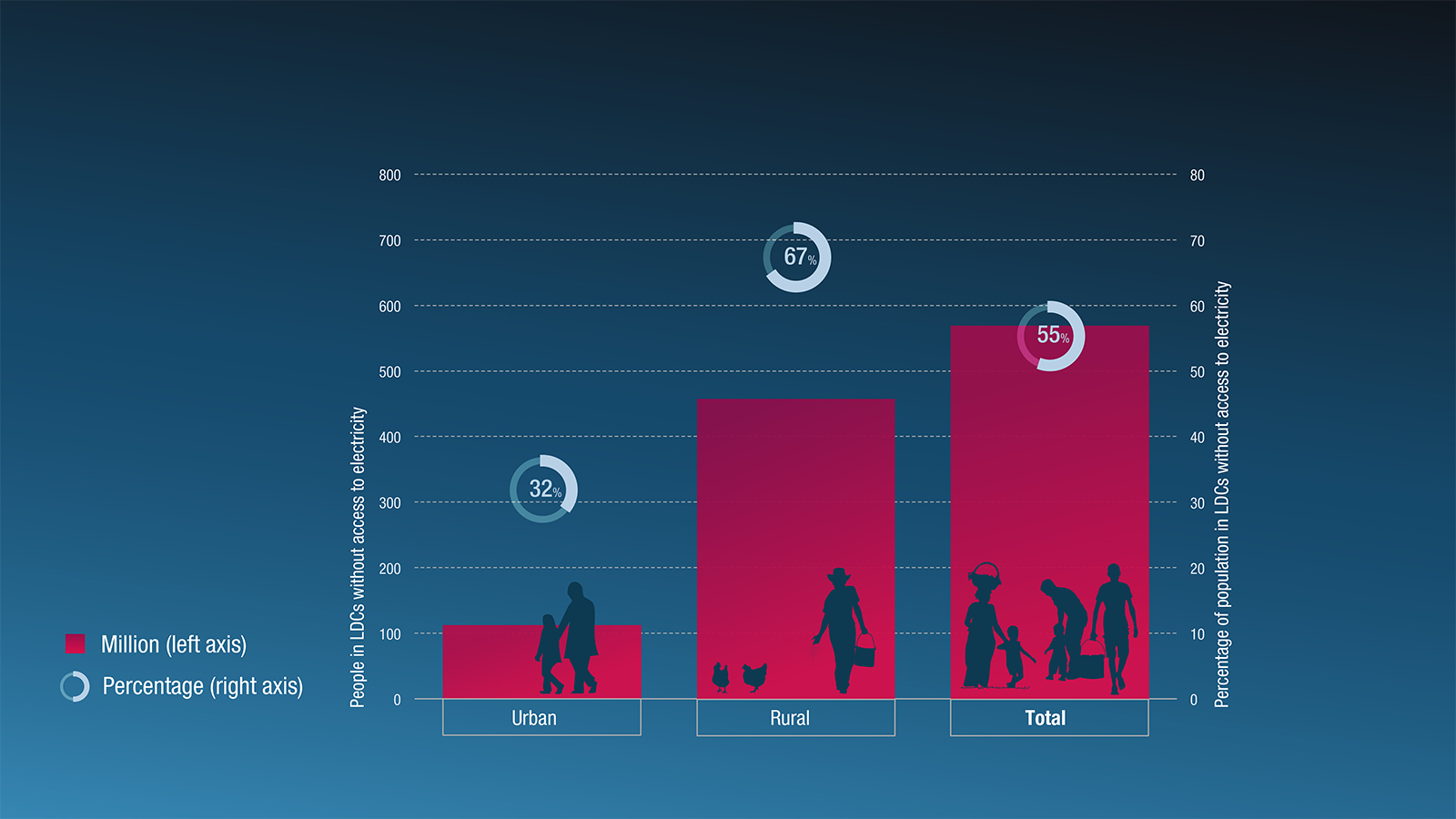Hundreds of millions of people worldwide still lack basic access to electricity, with most of them in least developed countries (LDCs).
Date: 1 July 2021
Source: UNCTAD calculations based on data from the International Energy Agency and UNCTADstat.
Note: Energy access data for Afghanistan, Bhutan, Kiribati, Solomon Islands, Timor-Leste and Tuvalu have been extrapolated using the LDC group average.
UNCTAD calculations show that, in 2019, more than half of the people living in LDCs lacked access to electricity. This is equivalent to some 570 million people, or about two thirds of the world population without electricity.
In a quarter of the world’s 46 LDCs, more than 75% of the population lack access to electricity. Rural electrification is particularly low, with two thirds of the rural LDC population (458 million people) completely without access.
Even in urban centres, up to one third of the population in LDCs doesn’t have access to electricity. And where electricity is available, access is often unreliable.
Energy access matters more than ever, as it’s closely linked to the response to the COVID-19 pandemic and key to health-care services. For example, where electricity access is poor, refrigeration of vaccines during transportation and storage may prove difficult, hampering vaccine roll-out.
Universal energy access remains elusive
Notwithstanding some improvements in electrification since 2000, the above figures underscore the extent to which LDCs are pivotal to achieving Sustainable Development Goal 7 on universal access to affordable, reliable, sustainable and modern energy.
Yet the progress recorded prior to COVID-19 was already insufficient to achieve universal access to energy by 2030, and the pandemic’s social and economic disruptions have worsened the situation, pushing many LDCs farther away from the SDG 7 target.
The heightened incidence of energy poverty – the lack of access to sustainable modern energy services and products – has wide-ranging implications on LDCs’ sustainable development prospects, not only in terms of personal welfare, but also of human capital accumulation and productive capacity development.
UNCTAD’s Productive Capacities Index reveals low scores on the energy component by LDCs. The lack of energy for productive purposes undermines the capacity of firms to competitively produce, including in rural non-farm activities, and export goods and services, limiting countries’ ability to grow economies.
How to address energy poverty
With the energy sector accounting for a sizeable share of LDCs’ sustainable development financing gap, redressing this situation will require greater investments in electricity generation and distribution, as well as in appropriate end-use capital technologies, such as machinery, equipment and household appliances.
Besides mobilizing financial resources for such investments, addressing energy poverty will also require deliberate policy measures to address potential tensions between the affordability of energy services and the financial viability of individual projects.
Success in this respect will also hinge on effectively embedding infrastructure development programmes in long-term development strategies for productive capacity development.
Renewable energy could power the global recovery from the pandemic in a greener and more sustainable way. LDCs’ current energy mix does rely on renewable sources, mainly hydropower, though there is potential to scale up its use.
Notably, these countries stand to gain from advances in renewable energy technologies and the emergence of decentralized electricity generation. This could spur rural electrification, where the costs of grid extension remain prohibitive.
For these potential gains to materialize, investment is needed in physical capital, as well as complementary skills, technological capabilities, and the know-how to master advanced green technologies and adapt them to specific contexts.
International support to promote access to green technologies and foster the emergence of conducive innovation systems could also go a long way in facilitating this transition.
Paying adequate attention to these issues, and to the complex relationships between energy, climate change and structural transformation, will be critical at a time when a global transition to a low-carbon energy system is all the more needed.
Download:
- The Least Developed Countries Report 2017 - Transformational energy access
- Theme Report on Energy Transition: Towards the achievement of SDG 7 and net-zero emissions

